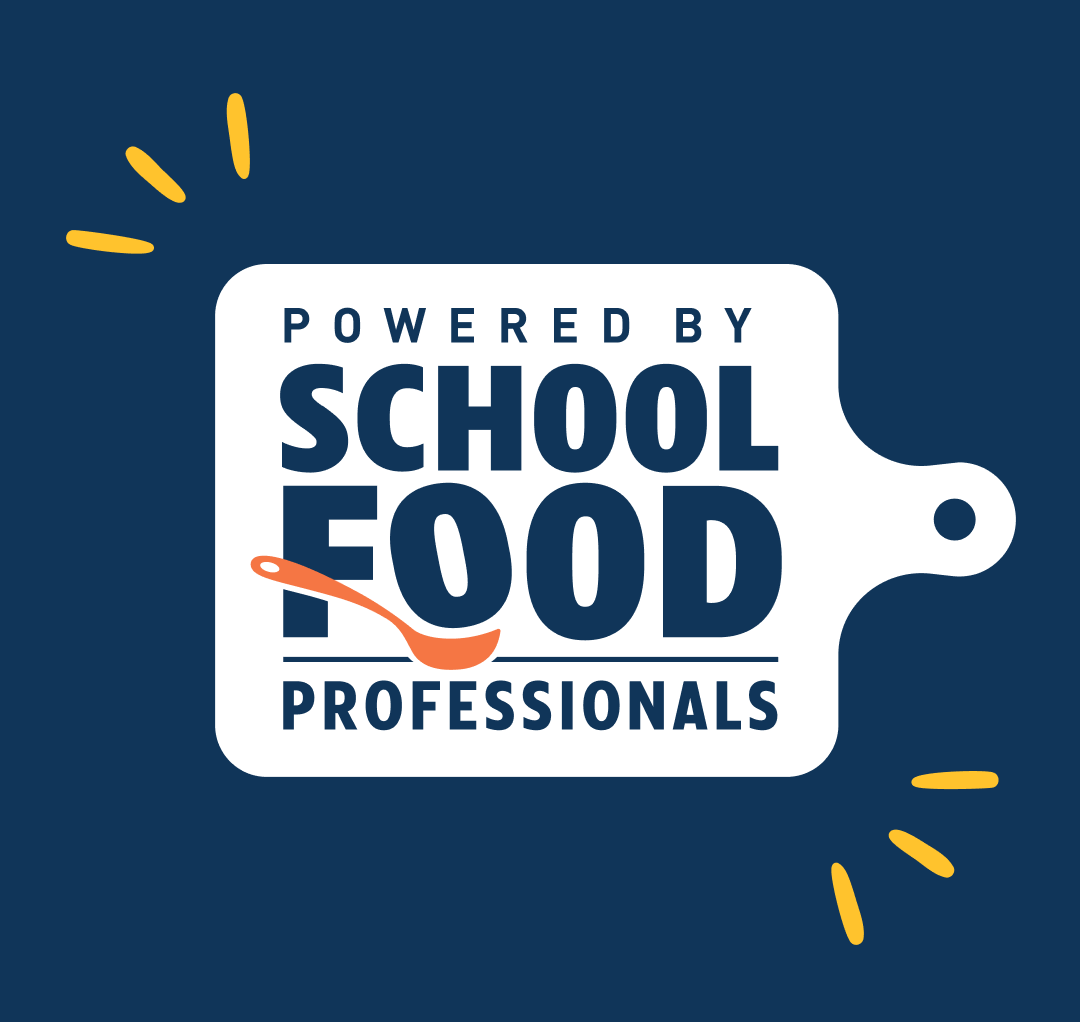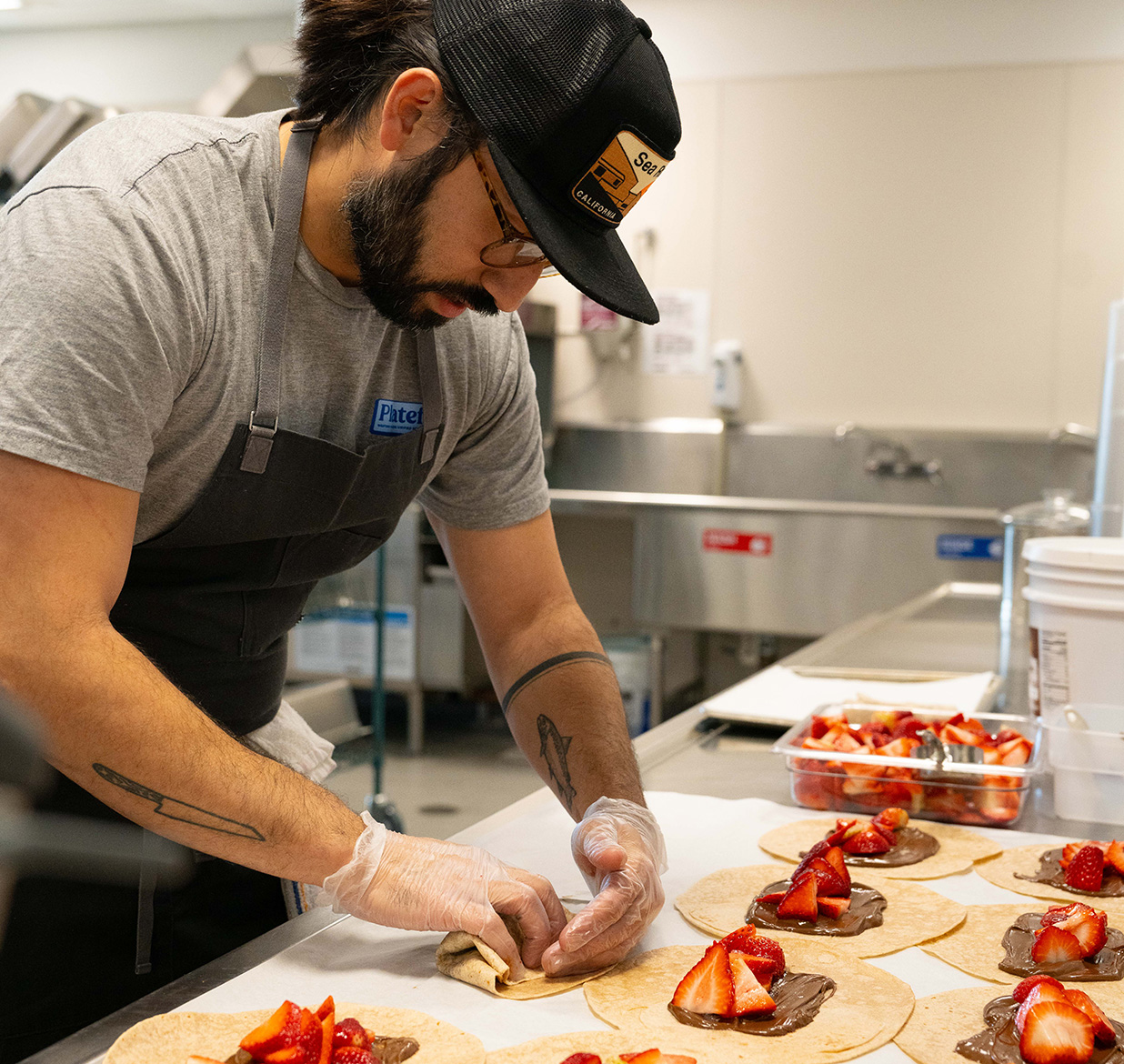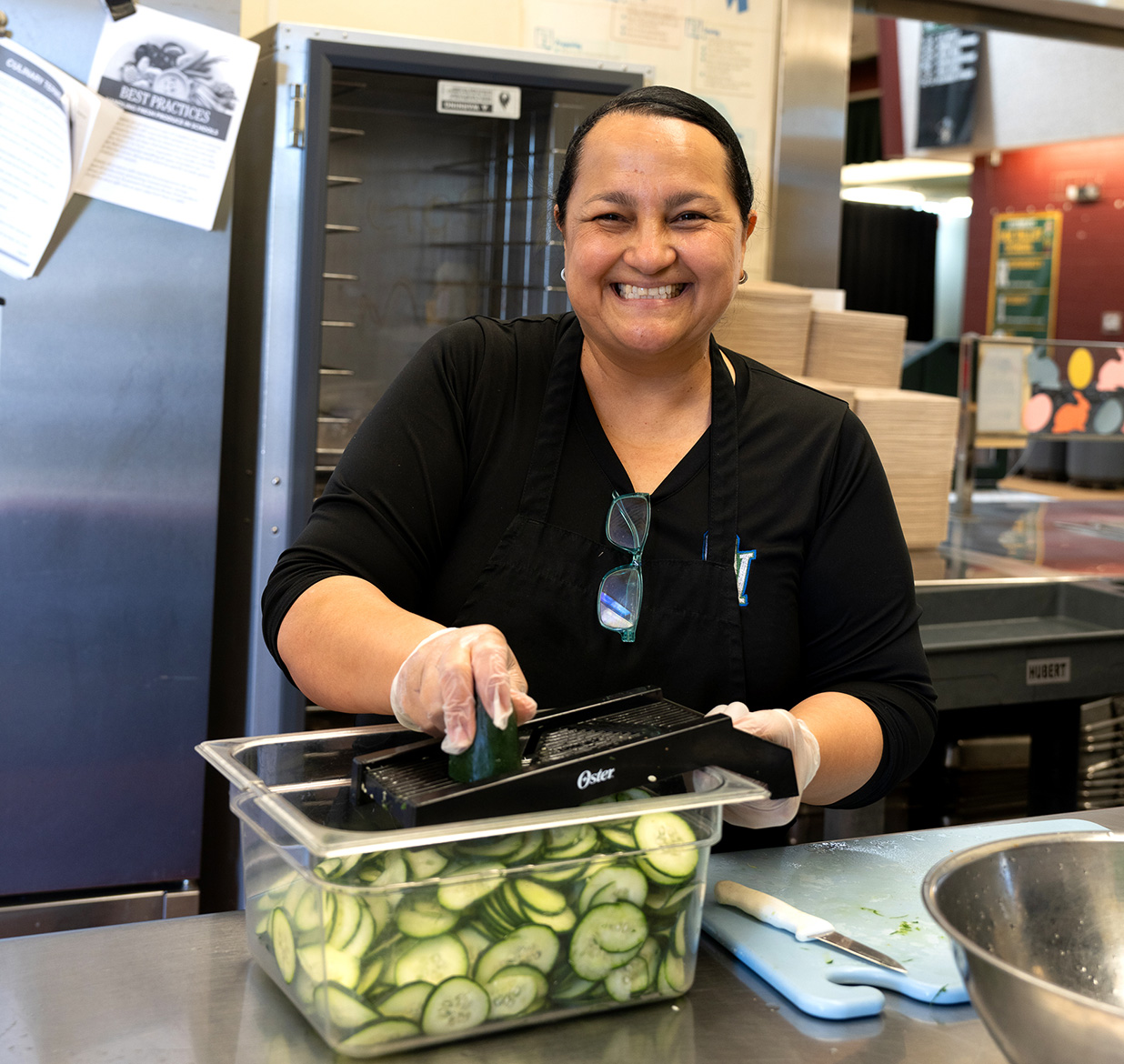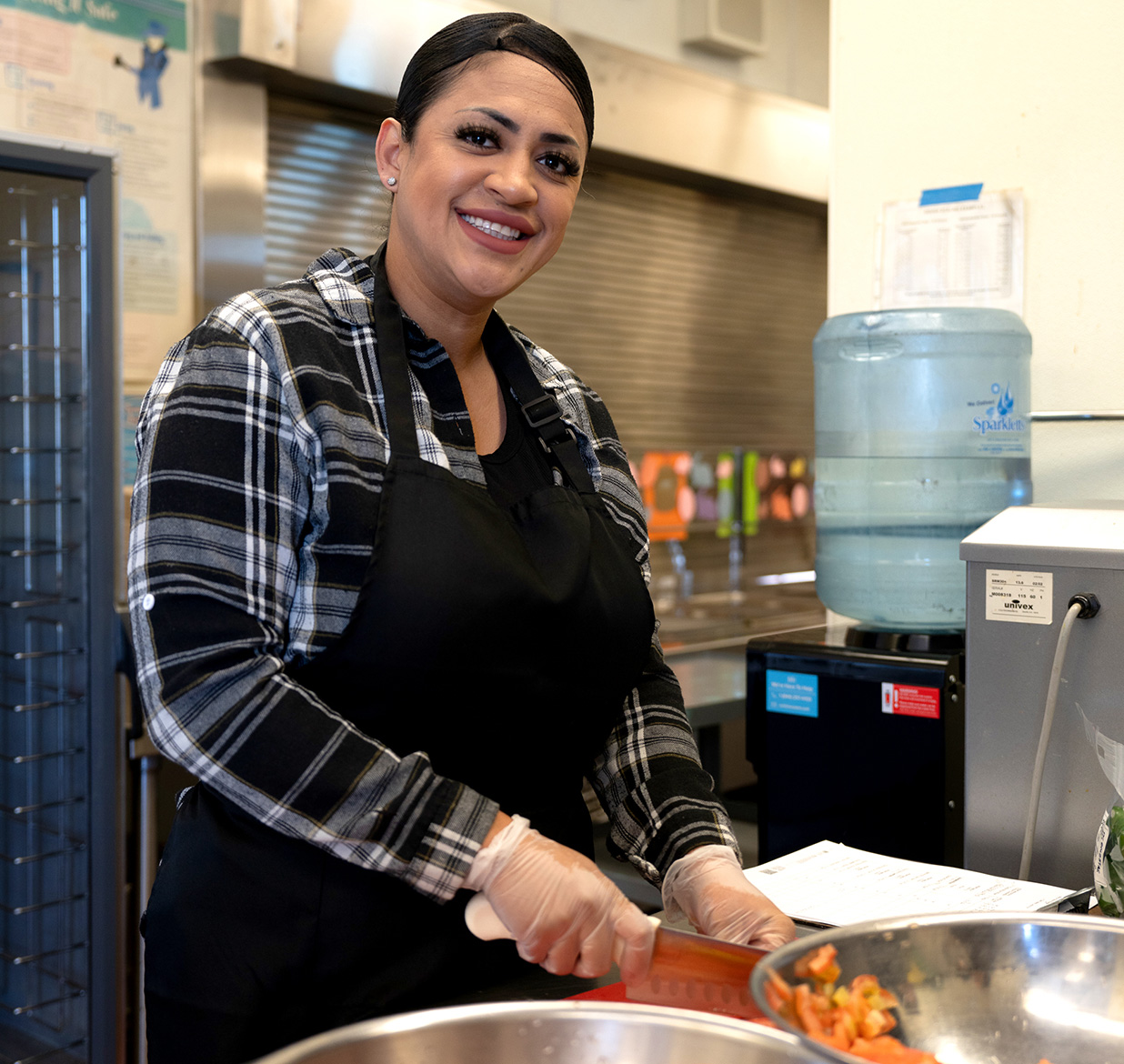
Why and How We Helped California Build a Campaign to Shift Perceptions About School Food Professionals
September 15, 2024 | By Melissa Cipollone
Powered by School Food Professionals is a first-of-its-kind public education campaign that puts a spotlight on the skill, creativity, and commitment of school food professionals working to improve school meals for kids across California. Backed by comprehensive audience research, the campaign serves as a model for other states seeking to dismantle barriers to school food change.
Changing the way schools feed nearly 30 million kids a day has the power to fundamentally transform the food system. School food professionals are at the center of this change, but their critical role in shaping our nation’s relationships with food, the environment, and each other is rarely recognized or understood among the general public.
That’s why we partnered with the state of California to launch a first-of-its-kind perception change campaign — Powered by School Food Professionals — to showcase the passion, skill, and creativity of school food professionals across the state who are working to make school meals fresher, healthier, and more appetizing.
Launched in April 2024, the year-long campaign can serve as a model for other states seeking to dismantle barriers to advancing school food change rooted in misperceptions about school food workers. These longheld misperceptions have real impacts on what gets served on the tray by perpetuating ongoing staff shortages, low wages, and problematic school food policies.
Telling the Stories of School Food Professionals
At the heart of the Powered by School Food Professionals campaign are the stories of school food professionals. While Californians might encounter the campaign message in a wide variety of formats — from billboards and online ads to social media posts and blogs — the campaign is grounded in short documentary-style videos that take California parents and their communities behind-the-scenes of school food jobs. Here are just a few of these stories.
Meet Stella Ndahura from Azusa Unified School District who, from personal experience, understands how school food affects a child’s ability to focus in the classroom and as well as their eating habits for life.
Meet Stella Ndahura from Azusa Unified School District who, from personal experience, understands how school food affects a child’s ability to focus in the classroom and as well as their eating habits for life.
Meet Nancy Gonzalez from Live Oak School District who works in school food because she loves to cook. She calls her favorite recipe “Nancy Muffins,” which are made with “a lot of love for all the kids.”
Meet Nancy Gonzalez from Live Oak School District who works in school food because she loves to cook. She calls her favorite recipe “Nancy Muffins,” which are made with “a lot of love for all the kids.”
Meet RJ Lane from West Contra Costa Unified School District who has worked as a school food professional for 25 years. Today, he leads a team making 15,000 meals for students every school day.
Meet RJ Lane from West Contra Costa Unified School District who has worked as a school food professional for 25 years. Today, he leads a team making 15,000 meals for students every school day.
These videos and others demonstrate how school food professionals are working to plan, prepare, and cook better quality meals for students to support their health and wellbeing — in the classroom and beyond.
Rooted in Research
To build the Powered by School Food Professionals campaign, we conducted extensive audience research. We worked with the researchers at Food for Climate League to conduct preliminary research to help to quantify public perceptions about school food workers, then to test what messaging themes most resonated with primary audiences — which included parents of current K–12 students and the broader school community. More than 1,800 Californians completed surveys for this research.
We also worked with public opinion researchers at Evitarus to host focus groups representative of the demographic and geographic diversity of parents of current K–12 public school students in California. Through these focus groups, we gained more nuanced insights into parents’ perceptions of school food and school food professionals. We also evaluated reactions to possible campaign messages and creative concepts to understand what resonated most with parents.
While parents cared deeply about their children’s health and the food they ate, parents also admitted to having little direct knowledge of or interaction with school food professionals and their working conditions. They assigned value to school food professionals based on the quality of meals currently being served to their children and not necessarily on the inherent importance of the role in influencing children’s health and food systems. This presented an opportunity to demonstrate to parents who school food professionals are, why they do what they do, and the wide variety of creative, skillful ways they are working to improve school meals for children.


Rooted in Research
To build the Powered by School Food Professionals campaign, we conducted extensive audience research. We worked with the researchers at Food for Climate League to conduct preliminary research to help to quantify public perceptions about school food workers, then to test what messaging themes most resonated with primary audiences — which included parents of current K–12 students and the broader school community. More than 1,800 Californians completed surveys for this research.
We also worked with public opinion researchers at Evitarus to host focus groups representative of the demographic and geographic diversity of parents of current K–12 public school students in California. Through these focus groups, we gained more nuanced insights into parents’ perceptions of school food and school food professionals. We also evaluated reactions to possible campaign messages and creative concepts to understand what resonated most with parents.
While parents cared deeply about their children’s health and the food they ate, parents also admitted to having little direct knowledge of or interaction with school food professionals and their working conditions. They assigned value to school food professionals based on the quality of meals currently being served to their children and not necessarily on the inherent importance of the role in influencing children’s health and food systems. This presented an opportunity to demonstrate to parents who school food professionals are, why they do what they do, and the wide variety of creative, skillful ways they are working to improve school meals for children.
While parents cared deeply about their children’s health and the food they ate, parents also admitted to having little direct knowledge of or interaction with school food professionals and their working conditions.
This audience research comprehensively shaped the Powered by School Food Professionals campaign name, messages, creative assets, and overarching strategy. Still, the ultimate measure of the campaign’s success will be whether it’s able to positively shift perceptions about school food professionals among parents of current K–12 students and the greater school community. We worked with our research partners to conduct baseline and mid-campaign audience surveys, and will be conducting a final audience survey at the end of the campaign to assess perception shift.
Once the campaign and this research is complete, we will be publishing a white paper in 2025 that will share the results of our research as well as insights detailing the campaign’s challenges and successes.
Reach to Date
While the campaign is around its halfway mark, its reach has so far exceeded projections. To date, Powered by School Food Professionals has cumulatively reached more than 11 million people through social media ads, streaming video, online influencers, radio, and billboards. Campaign ads were viewed a total of 29 million times and more than 65,000 people have visited the campaign website.
Additionally, we’ve worked with social media creators that include parents, teachers, collegiate student-athletes, chefs, and foodies who have a combined reach of more than 6 million followers across Instagram and TikTok to share their own stories about their connection to school food and how it’s influenced them, their kids, and their communities. For example, Joanne Molinaro — also known as The Korean Vegan — highlights how Korean foods are now appearing on school lunch menus, as well as why Korean recipes are well suited for cooking in bulk.
We’re looking forward to continuing to grow the campaign over the course of the 2024–25 school year.


Reach to Date
While the campaign is around its halfway mark, its reach has so far exceeded projections. To date, Powered by School Food Professionals has cumulatively reached more than 11 million people through social media ads, streaming video, online influencers, radio, and billboards. Campaign ads were viewed a total of 29 million times and more than 65,000 people have visited the campaign website.
Additionally, we’ve worked with social media creators that include parents, teachers, collegiate student-athletes, chefs, and foodies who have a combined reach of more than 6 million followers across Instagram and TikTok to share their own stories about their connection to school food and how it’s influenced them, their kids, and their communities. For example, Joanne Molinaro — also known as The Korean Vegan — highlights how Korean foods are now appearing on school lunch menus, as well as why Korean recipes are well suited for cooking in bulk.
We’re looking forward to continuing to grow the campaign over the course of the 2024–25 school year.
A Model for Other States
We applaud California for its investment in uplifting school food professionals, who are the cornerstone of school food change. We encourage other states that understand the opportunity better school food represents to similarly focus on showcasing the value of the labor force needed to advance school food goals.
School food change is much more difficult when parents and other stakeholders don’t recognize the critical role school food professionals play in supporting children’s health and wellbeing, as well as how they impact communities and the food system at large.
By sharing our journey building and executing this research-backed campaign, we hope it provides valuable insights other states can draw from as they work to improve the quality of the food schools serve to children.


A Model for Other States
We applaud California for its investment in uplifting school food professionals, who are the cornerstone of school food change. We encourage other states that understand the opportunity better school food represents to similarly focus on showcasing the value of the labor force needed to advance school food goals.
School food change is much more difficult when parents and other stakeholders don’t recognize the critical role school food professionals play in supporting children’s health and wellbeing, as well as how they impact communities and the food system at large.
By sharing our journey building and executing this research-backed campaign, we hope it provides valuable insights other states can draw from as they work to improve the quality of the food schools serve to children.
Join us!
You can follow along with the Powered by School Food Professionals campaign by subscribing to the campaign’s newsletter. You can also follow the campaign on social media on Instagram, LinkedIn, YouTube, and Facebook.
Powered by School Food Professionals is managed by the Chef Ann Foundation through a grant provided by the California Community Colleges Chancellor’s Office and in partnership with the State of California. This effort has received tremendous support and guidance from an advisory committee composed of California-based leaders across school food, labor, education, agriculture, nonprofits and philanthropy.
Special thanks to Fenton, Evitarus, Food for Climate League, and the many California school food professionals who helped make this campaign happen.






